T^3 International Conference 2018: Summary and Postmortem
Published by KermMartian
6 years, 1 month ago (2018-03-05T07:18:30+00:00)
| Discuss this article
Last Thursday, I set out to attend Texas Instruments' annual T^3 International Conference 2018, and after an exhausting, whirlwind weekend of teaching, learning, meetings, coding, and a bit of exploration in San Antonio, Texas, I'm homeward-bound. The annual T^3 conference is an opportunity for math, science, and computer science teachers and administrators to get together and teach each other, especially regarding using TI's technology in the classroom. It's a unique experience in that the sessions are centered around TI graphing calculators (and now STEM and robotics education tools), but the majority of the sessions are taught by regular teachers from around the country (and in some cases the world) who are enthusiastic about sharing with each other. This is my sixth year attending, and although Thomas "elfprince13" Dickerson was supposed to join me, mechanical mishaps and winter storms left me Cemetech's sole representative at the conference.I attended wearing several of my Cemetech hats: I taught a session about integrating TI-BASIC in the classroom with my teacher hat. I tweeted madly as myself and as Cemetech and took notes for this and other Cemetech news articles with my journalist hat. And I explored how Cemetech and the community as a whole can remain relevant as a partner both of students enthusiastic to teach themselves programming and their teachers who want to encourage important STEM literacy.
Days 0 and 1
A late afternoon arrival in San Antonio on Thursday gave me an opportunity to make my way leisurely to the conference hotel, briefly explore San Antonio's Riverwalk attraction, and have dinner and polish off my presentation for the first session of the conference. Bright and early on Friday morning, March 2nd, T^3 kicked off with an opening session beginning with Dr. Peter Balyta's remarks (President of TI Education, Vice President of Texas Instruments, and vocal advocate of calculators as programming and STEM education cools) and continuing with a keynote by John C. Urshel, retired NFL player for the Baltimore Ravens, current MIT doctoral candidate in applied math, and current TI Education spokesperson. In an unexpected first for our TI conference experiences, Mr. Urschel and Dr. Balyta took the stage together to field questions from the live audience and from participants on Facebook Live. They touched on subjects ranging from financial literacy among football players and young adults as a whole, to increasing educational opportunities in minority, underserved, and underfunded districts, to why it makes mathematical sense to be a coder or mathematician instead of a football player. From there, the conference broke for a day of individual sessions.
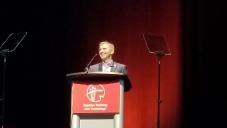
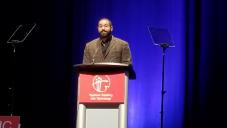
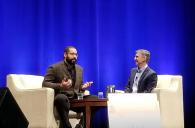
My own talk, "Teaching Beginner Computer Science Concepts with the TI-84 Plus", was reasonably well-attended, by teachers with previous coding experience ranging from "absolutely none" to "have written C and C++". I tried to pack rather a lot into my 1.5-hour session, starting with why you should teach programming with TI graphing calculators, how TI's resource, Cemetech's resources, and Programming the TI-83 Plus/TI-84 Plus can help. I spent the remainder of the time on a "Hello, World" program, on a brain-bending introducion to most of the programming commands on the calculator, and an encore in which I did something I've never tried before: taught 3D rendering and rotation on the graphscreen. I provided the slides (linked above and below) to the attendees, so I hope they and you will have a chance to experience with the surprisingly approachable concept of 3D rendering. I also raffled off three copies of my books to attendees at the very end. With that under my belt, I was unfettered to enjoy the rest of the day's sessions. I took a look at the latest projects TI's engineers and partner schools had created with the TI-Innovator Hub and the TI-Innovator Rover in the STEM room. I attended a session in which the instructors related their experiences teaching students the engineering process by having them design and test ramps with 3D printing, TI calculators, the CBR (Calculator-Based Ranger), and rubber balls and model yellow Hummers. I won a #GenSTEM tee shirt from the TI social media team. I attended a session where we figured out how many chairs and tables Emmet could create with a set of LEGO bricks and how he could maximize his profits, then used TI-84 Plus CEs to graph the resulting possibilities. The day ended with the traditional Day 1 reception, this one 1980s-themed thanks to this being the conference's 30th year. With the help of a cadre of friendly Australian TIers I managed to figure out all 1980s music trivia in the session's trivia quiz, and I enjoyed good food, good music, and good stories.



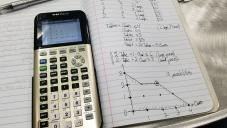
Day 2
The second full day of the conference tends to be the one most packed with content, going from 8:30am to 4:30pm with a full roster of sessions by teachers, for teachers. In my very first session, I utterly failed to remember to eat my overpriced hotel breakfast bagel, so engrossed was I in playing with the new TI-Innovator Rover. I'm hoping to be able to bring you all a hands-on review soon. The session was entitled "Crashing on Purpose: Intersection Point and the TI-Innovator Rover", and I worked with four other teachers to try to make our Rovers move along the paths of intersecting functions. Two of the teachers with whom I was working had some experience with the Rover, and the other two had none; it was fascinating to see the teachers' willingness to explore with the rovers and to watch them consider "what if I try..." both to solve the problem at hand and to explore the Rover's capabilities. I'm intrigued to see how that will compare with how students will interact with the Rover. I followed that with two coding-centric sessions, one a more measured approach to integrating math programs in algebra and geometry curricula, the other exploring music theory by playing music with the TI-Innovator Hub and TI-Nspires (I got slightly distracted and made a piano program on my TI-84 Plus CE instead). Especially in the latter session, it was gratifying to see just how excited the teachers were about the combination of the music theory math and the calculator demonstration of the concepts. I found retired steam trains and very not-retired freight trains before lunch. I ended the day's sessions with "Problems Worth Coding, Episode II", a fun session highlighting the kinds of problems that are infeasible to iteratively solve by hand but which can be easily solved with a calculator program. That left me with an evening to catch up on a precarious pile of Geopipe obligations.

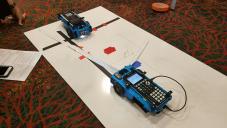
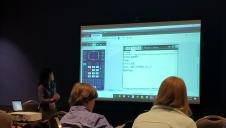
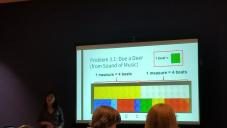

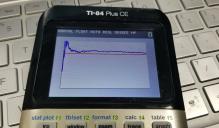
Day 3 and Final Thoughts
In the interest of topics not exactly fitting our focus, health, sanity, and a red-eye flight, I forebore attending the Sunday morning Power Sessions, instead concluding the conference at the closing session. Dr. Balyta introduced a closing address by Jennifer Bartkowski, CEO of the Girl Scouts of Northeast Texas, about the root causes of the deficiencies of women in STEM fields and how we can help build girls' (and everyone's) confidence, not just competence, in STEM skills. On that high note, the conference ended, to convene in March 2019 in Baltimore, Maryland. I spent the rest of the day exploring the intricacies of San Antonio's VIA bus system when services get rerouted, walking and riding a wonderful miniature railroad () through San Antonio's Brackenridge Park, eating loaded hot dogs, and eventually spending many tired hours on planes. I have a full to-do list of followups from the conference for each of my several hats, and I look forward to hopefully being able to share those as they get underway. Perhaps more importantly, it's always helpful to refresh my perspective of one of the reasons we do everything we do at Cemetech. Providing a place where students and others can share their work and get help from each other is a very important part of that mission. Helping teachers teach is another important part, which we partially do with SourceCoder and jsTIfied, but which I think we can continue to better. Moreover, we have a longstanding mission to spread love for and skill in programming and electronics, and I look forward to how that mission will continue to evolve as the tools and curricula that beginners use evolve.
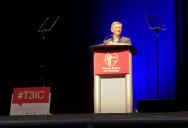

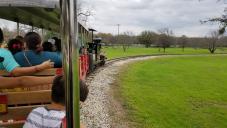
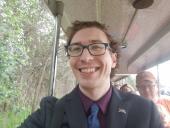

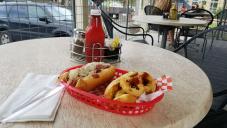
When I first attended T^3 2013 in Philadelphia, PA, teachers seemed largely suspicious of programming in the classroom, especially with calculators, and I taught one of the only programming sessions at that T^3. Starting about three years ago, I saw that attitude begin to evolve, slowly at first and picking up speed, especially as with new products and new leadership TI Education itself began to embrace its calculators as STEM and programming tools. This year marked an obvious continuation of that pattern: few teachers to whom I spoke weren't excited about the Rover, the Innovator, programming, or some combination of the three. In fact, I think the Rover has captures teachers' imaginations more than the Innovator Hub, possibly because they don't need to learn and then impart the necessary electrical engineering skills to build something with the Hub in the first place before writing the relevant code to control their creations (or possibly for other reasons I haven't yet gleaned). I'm looking forward to seeing how adoption of these tools evolves over the next year, and what kinds of presentations we see (and give!) at next year's T^3. If you've outgrown your student boots and are interested in attending as an educator or a (respectful) Cemetechian, I strongly encourage it. Finally, if you have any questions about my experiences, feel free to post and I'll try to answer! I just landed back home, and they're trying to determine if my plane's brakes are on fire. Good night.
Download
 Teaching Beginner Computer Science Concepts with the TI-84 Plus CE (and TI-83 Plus, TI-84 Plus, and TI-84 Plus C Silver Edition)
Teaching Beginner Computer Science Concepts with the TI-84 Plus CE (and TI-83 Plus, TI-84 Plus, and TI-84 Plus C Silver Edition)

Permalink
Last Thursday, I set out to attend Texas Instruments' annual T^3 International Conference 2018, and after an exhausting, whirlwind weekend of teaching, learning, meetings, coding, and a bit of exploration in San Antonio, Texas, I'm homeward-bound. The annual T^3 conference is an opportunity for math, science, and computer science teachers and administrators to get together and teach each other, especially regarding using TI's technology in the classroom. It's a unique experience in that the sessions are centered around TI graphing calculators (and now STEM and robotics education tools), but the majority of the sessions are taught by regular teachers from around the country (and in some cases the world) who are enthusiastic about sharing with each other. This is my sixth year attending, and although Thomas "elfprince13" Dickerson was supposed to join me, mechanical mishaps and winter storms left me Cemetech's sole representative at the conference.I attended wearing several of my Cemetech hats: I taught a session about integrating TI-BASIC in the classroom with my teacher hat. I tweeted madly as myself and as Cemetech and took notes for this and other Cemetech news articles with my journalist hat. And I explored how Cemetech and the community as a whole can remain relevant as a partner both of students enthusiastic to teach themselves programming and their teachers who want to encourage important STEM literacy.
Days 0 and 1
A late afternoon arrival in San Antonio on Thursday gave me an opportunity to make my way leisurely to the conference hotel, briefly explore San Antonio's Riverwalk attraction, and have dinner and polish off my presentation for the first session of the conference. Bright and early on Friday morning, March 2nd, T^3 kicked off with an opening session beginning with Dr. Peter Balyta's remarks (President of TI Education, Vice President of Texas Instruments, and vocal advocate of calculators as programming and STEM education cools) and continuing with a keynote by John C. Urshel, retired NFL player for the Baltimore Ravens, current MIT doctoral candidate in applied math, and current TI Education spokesperson. In an unexpected first for our TI conference experiences, Mr. Urschel and Dr. Balyta took the stage together to field questions from the live audience and from participants on Facebook Live. They touched on subjects ranging from financial literacy among football players and young adults as a whole, to increasing educational opportunities in minority, underserved, and underfunded districts, to why it makes mathematical sense to be a coder or mathematician instead of a football player. From there, the conference broke for a day of individual sessions.



My own talk, "Teaching Beginner Computer Science Concepts with the TI-84 Plus", was reasonably well-attended, by teachers with previous coding experience ranging from "absolutely none" to "have written C and C++". I tried to pack rather a lot into my 1.5-hour session, starting with why you should teach programming with TI graphing calculators, how TI's resource, Cemetech's resources, and Programming the TI-83 Plus/TI-84 Plus can help. I spent the remainder of the time on a "Hello, World" program, on a brain-bending introducion to most of the programming commands on the calculator, and an encore in which I did something I've never tried before: taught 3D rendering and rotation on the graphscreen. I provided the slides (linked above and below) to the attendees, so I hope they and you will have a chance to experience with the surprisingly approachable concept of 3D rendering. I also raffled off three copies of my books to attendees at the very end. With that under my belt, I was unfettered to enjoy the rest of the day's sessions. I took a look at the latest projects TI's engineers and partner schools had created with the TI-Innovator Hub and the TI-Innovator Rover in the STEM room. I attended a session in which the instructors related their experiences teaching students the engineering process by having them design and test ramps with 3D printing, TI calculators, the CBR (Calculator-Based Ranger), and rubber balls and model yellow Hummers. I won a #GenSTEM tee shirt from the TI social media team. I attended a session where we figured out how many chairs and tables Emmet could create with a set of LEGO bricks and how he could maximize his profits, then used TI-84 Plus CEs to graph the resulting possibilities. The day ended with the traditional Day 1 reception, this one 1980s-themed thanks to this being the conference's 30th year. With the help of a cadre of friendly Australian TIers I managed to figure out all 1980s music trivia in the session's trivia quiz, and I enjoyed good food, good music, and good stories.




Day 2
The second full day of the conference tends to be the one most packed with content, going from 8:30am to 4:30pm with a full roster of sessions by teachers, for teachers. In my very first session, I utterly failed to remember to eat my overpriced hotel breakfast bagel, so engrossed was I in playing with the new TI-Innovator Rover. I'm hoping to be able to bring you all a hands-on review soon. The session was entitled "Crashing on Purpose: Intersection Point and the TI-Innovator Rover", and I worked with four other teachers to try to make our Rovers move along the paths of intersecting functions. Two of the teachers with whom I was working had some experience with the Rover, and the other two had none; it was fascinating to see the teachers' willingness to explore with the rovers and to watch them consider "what if I try..." both to solve the problem at hand and to explore the Rover's capabilities. I'm intrigued to see how that will compare with how students will interact with the Rover. I followed that with two coding-centric sessions, one a more measured approach to integrating math programs in algebra and geometry curricula, the other exploring music theory by playing music with the TI-Innovator Hub and TI-Nspires (I got slightly distracted and made a piano program on my TI-84 Plus CE instead). Especially in the latter session, it was gratifying to see just how excited the teachers were about the combination of the music theory math and the calculator demonstration of the concepts. I found retired steam trains and very not-retired freight trains before lunch. I ended the day's sessions with "Problems Worth Coding, Episode II", a fun session highlighting the kinds of problems that are infeasible to iteratively solve by hand but which can be easily solved with a calculator program. That left me with an evening to catch up on a precarious pile of Geopipe obligations.






Day 3 and Final Thoughts
In the interest of topics not exactly fitting our focus, health, sanity, and a red-eye flight, I forebore attending the Sunday morning Power Sessions, instead concluding the conference at the closing session. Dr. Balyta introduced a closing address by Jennifer Bartkowski, CEO of the Girl Scouts of Northeast Texas, about the root causes of the deficiencies of women in STEM fields and how we can help build girls' (and everyone's) confidence, not just competence, in STEM skills. On that high note, the conference ended, to convene in March 2019 in Baltimore, Maryland. I spent the rest of the day exploring the intricacies of San Antonio's VIA bus system when services get rerouted, walking and riding a wonderful miniature railroad () through San Antonio's Brackenridge Park, eating loaded hot dogs, and eventually spending many tired hours on planes. I have a full to-do list of followups from the conference for each of my several hats, and I look forward to hopefully being able to share those as they get underway. Perhaps more importantly, it's always helpful to refresh my perspective of one of the reasons we do everything we do at Cemetech. Providing a place where students and others can share their work and get help from each other is a very important part of that mission. Helping teachers teach is another important part, which we partially do with SourceCoder and jsTIfied, but which I think we can continue to better. Moreover, we have a longstanding mission to spread love for and skill in programming and electronics, and I look forward to how that mission will continue to evolve as the tools and curricula that beginners use evolve.






When I first attended T^3 2013 in Philadelphia, PA, teachers seemed largely suspicious of programming in the classroom, especially with calculators, and I taught one of the only programming sessions at that T^3. Starting about three years ago, I saw that attitude begin to evolve, slowly at first and picking up speed, especially as with new products and new leadership TI Education itself began to embrace its calculators as STEM and programming tools. This year marked an obvious continuation of that pattern: few teachers to whom I spoke weren't excited about the Rover, the Innovator, programming, or some combination of the three. In fact, I think the Rover has captures teachers' imaginations more than the Innovator Hub, possibly because they don't need to learn and then impart the necessary electrical engineering skills to build something with the Hub in the first place before writing the relevant code to control their creations (or possibly for other reasons I haven't yet gleaned). I'm looking forward to seeing how adoption of these tools evolves over the next year, and what kinds of presentations we see (and give!) at next year's T^3. If you've outgrown your student boots and are interested in attending as an educator or a (respectful) Cemetechian, I strongly encourage it. Finally, if you have any questions about my experiences, feel free to post and I'll try to answer! I just landed back home, and they're trying to determine if my plane's brakes are on fire. Good night.
Download
 Teaching Beginner Computer Science Concepts with the TI-84 Plus CE (and TI-83 Plus, TI-84 Plus, and TI-84 Plus C Silver Edition)
Teaching Beginner Computer Science Concepts with the TI-84 Plus CE (and TI-83 Plus, TI-84 Plus, and TI-84 Plus C Silver Edition)

Permalink
Advertisement

